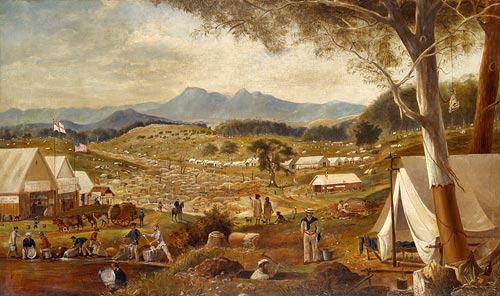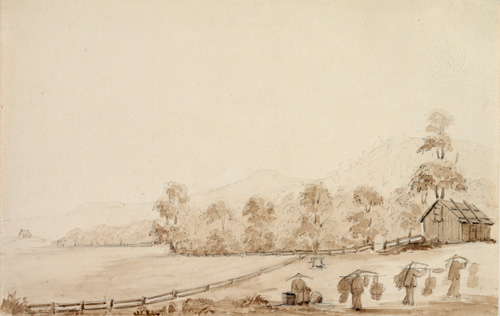Minority Miners
The goldfields attracted diggers from many nations. Germans, Italians, Poles, American, Chinese, Irish, Scottish and English were just some of the nationalities, along with the native born who ventured out of the towns to the goldfields.

Gold diggings, Ararat, ca. 1855, by Edward Roper
Oil painting, DL 15
Diggers would fly flags from their tents indicating their nationality. The array of flags included the Union Jack, a Scottish thistle, the Fleur-de-lys and the Texas Star. Hotels would fly the flags of the languages that were spoken within.
Read an account by an Italian digger in Victoria
The mateship and egalitarian atmosphere felt amongst diggers did not extend to the Chinese diggers.
Chinese miners arrived on the Australian gold fields around 1854. Often referred to in the contemporary literature as celestials (children of the sun), they were viewed by large sections of society with suspicion and racism because of their different language, dress, food and customs.
There were around 17,000 Chinese on the goldfields by mid 1855. Labouring together, the Chinese miners would only work the diggings that had already been worked and deserted by Europeans. Yet they were still accused of taking white men’s claims and were often the scapegoats as disgruntled miners blamed their misfortunes on them.
View a gold medal presented by Chinese miners to a Commissioner of the Braidwood goldfield
Many of the Chinese miners returned to their families in China, however there were some who stayed, including Quong Tart. He had migrated to Australia, aged nine, with his uncle and moved to the Braidwood goldfields. Quickly assimilating into the Australian way of life, he developed into a fine cricketer and sportsman, a Freemason and local entrepreneur. He became a wealthy tea merchant and restaurateur and was also a highly respected figure, philanthropist and community leader for the Chinese community in New South Wales.
Read correspondence to Quong Tart and family
Anti-Chinese riots also occurred in Bendigo in July 1854 and the first of the anti-Chinese immigration legislation was introduced in Victoria. An entry tax was imposed of £10 for each Chinese immigrant arriving in Melbourne. Evading the tax by entering via South Australia, Chinese miners travelled inland to the diggings. It was Chinese miners who discovered the rich deposits of gold at Ararat. The Chinese successes at Ararat caused jealousy and anger from the other miners as they were able to claim the best areas on the diggings.

Untitled landscape showing Chinese workers in foreground, 1860, by Mrs B.H. Martindale
Watercolour drawing, PXA 2498/5
One of the worst anti-Chinese riots occurred at Lambing Flat (now Young) in New South Wales. In the winter of 1861 a brass band playing Rule Britannia urged on a few thousand white miners carrying anti-chinese banners who descended upon the Chinese camp. The Chinese miners were attacked, assaulted and their camp set on fire. A small police presence was ineffective in preventing the violence. Almost five hundred were injured in the attack and over one thousand Chinese miners fled from the Lambing Flat goldfield.
The pressure of anti-chinese feelings in Australian society encouraged the NSW government to introduce the Immigration Restriction Act and Regulations in 1861, reducing numbers of Chinese immigration and preparing the way for the first piece of Federal government legislation in 1901: the Immigration Restriction Act.




